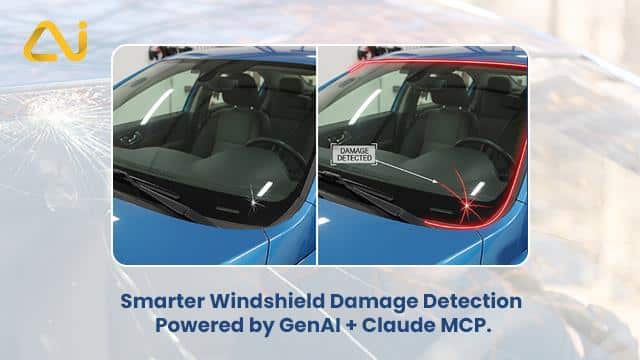Is This Windshield Damaged?
Enhancing Windshield Damage Assessment with Claim Genius’s Proprietary GenAI damage detection and Anthropic Claude’s Model Context Protocol (MCP) Framework. Default LLMs like Claude or ChatGPT fail to provide domain specific solution to complex problems like Windshield Damage Detection but integration with Claim Genius’s GenAI MCP tool server allows state of the art LLMs to make correct judgement on windshield damages in seconds.
Executive Summary
Identifying windshield damage from vehicle photos is inherently challenging due to the complex visual environment in which images are captured. Several external factors can distort the image and lead to false positives or misclassification, including:
- Lighting Conditions: Overexposure, reflections, or insufficient lighting can obscure or exaggerate the appearance of cracks or chips.
- Glare and Reflections: Sunlight or reflections from surrounding surfaces can mimic the appearance of damage.
- Shadows from Trees, Buildings, or Overhead Wires: These can create visual artifacts that resemble cracks or scratches on the windshield.
- Image Angle and Quality: The orientation and resolution of the image can affect the visibility of actual damage and make detection more difficult.
This variability makes it extremely difficult for generic AI models to reliably assess windshield condition. They often lack the contextual awareness to distinguish between actual damage and environmental noise.
At Claim Genius, our proprietary GenAI pipeline is designed to overcome these limitations. By combining specialized models (for detecting image angle, part presence, and environmental cues) with a domain-trained LLM, we ensure that the final judgment is made based on contextual intelligence, not just raw pixels.
In the automotive insurance industry, accurate and timely damage assessment is critical – especially for high-frequency claim areas such as windshield damage. While general purpose large language models (LLMs) like Claude and ChatGPT offer general insights, they lack the domain-specific intelligence needed for visual and contextual understanding.
This white paper presents Claim Genius’s proprietary GenAI and ML-based architecture, enhanced by a MCP system, that dramatically improves the accuracy, speed, and reliability of windshield damage assessments. By orchestrating a network of specialized AI tools and leveraging a domain-trained LLM, our system turns complex image data into actionable claim-level insights.
The Problem: Why General-Purpose LLMs Fall Short Insurance adjusters, like John in our case study, increasingly rely on AI tools to manage their growing workload. When John adopted Claude Desktop, he gained basic support with text-based tasks – but complex visual challenges, like determining windshield damage, remained out of reach.
Generic LLMs are not designed for:
- Interpreting visual automotive data
- Detecting damage location and severity in images
- Understanding spatial context or part orientation
- Coordinating multiple sources of structured visual data
Asking a general-purpose LLM to perform specialized damage assessment is like asking a general physician to perform heart surgery – the tool is simply not trained for the task.
Read full information about WhitePaper here

